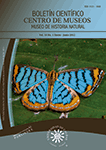Autores/as
Resumen
La depredación ha sido un importante agente de selección natural que ha dirigido la evolución de varias características de los anfibios, tales como las secreciones de sustancias toxicas y desagradables, la coloración críptica y aposemática, y una variedad de posturas y comportamientos defensivos. En este trabajo se describe por primera vez los comportamientos realizados por la rana de cristal Centrolene savagei, para evitar la depredación. Dichos comportamientos consistieron en asumir pasturas de defensa, liberar fluidos cloacales y producir secreciones olorosas al momento de ser estimulados visual y táctimente los individuos. La adopción de posturas de defensa y la secreción de sustancias olorosas, se constituye como el primer registro de dichos comportamientos para la familia Centrolenidae, demostrando así que muchos aspectos de la historia natural de las ranas de cristal siguen siendo desconocidos.
Citas
CEI, J. M., 1980. Amphibians of Argentina. Monit. Zool. Ital., 2: 1-609.
CEI, J. M. & ERSPAMER, V., 1966. Biochemical taxonomy of South American amphibians by means of skin amines and polypeptides. Copeia, 1966: 74-78.
CISNEROS-HEREDIA, D. F. & MCDIARMID, R. W., 2007. Revision of the characters of Centrolenidae (Amphibia: Anura: Athesphatanura), with comments on its taxonomy and the description of new taxa of glassfrogs. Zootaxa, 1572: 1-82.
DAS, I., SENGUPTA, S. & DAS, A., 2010. Hylarana leptoglossa (Long-tongued Frog). Defensive Behavior. Herpetological Review, 41: 196-197.
DELIA, J., CISNEROS-HEREDIA, D. F., WHITNEY, J. & MURRIETA-GALINDO, R., 2010. Observations on the Reproductive Behavior of a Neotropical Glassfrog, Hyalinobatrachium fleischmanni (Anura: Centrolenidae). South American Journal of Herpetology, 5: 1-12.
DRAKE, D. L. & RANVESTEL, A. W., 2005. Hyalinobathrachium colymbiphyllum (glass frog). Egg mass defense. Herpetological Review, 36: 434.
GUAYASAMIN, J. M., CASTROVIEJO-FISHER, S., TRUEB, L., AYARZAGÜENA, J., RADA, M. & VILÀ, C., 2009. Phylogenetic systematics of glassfrogs (Amphibia: Centrolenidae) and their sister taxon Allophryne ruthveni. Zootaxa, 2100: 1-97.
HANSON, J. A. & VIAL, J. L., 1956. Defensive behavior and effects of toxins in Bufo alvarius. Herpetologica, 12: 141-49.
HARTSHORM, G. S., 2002. Biogeografía de bosques neotropicales: 59-81 (en) GUARIGUATA, M. R. & KATTAN, G. H. (eds.) Ecología y Conservación de Bosques Neotropicales. Cartago, Colombia. Ediciones LUR.
HAWLEY, T. J. & CHASTAIN, L., 2007. Hyalinobatrachium pulveratum (Chiriqui Glass Frog). Predation. Herpetological Review, 38: 427-438.
HAYES, M., 1983. Predation on the adults and prehatching stages of glass frogs (Centrolenidae). Biotropica, 15: 74-76.
HERTZ, A. & LOTZKAT, S., 2010. Cochranella albomaculata (White-spotted Cochran Frog). Predation. Herpetological Review, 41: 194.
HOLDRIDGE, L. R., 1982. Ecología Basada en Zonas de Vida. San José, Costa Rica. IICA.
LUTZ, B., 1966. Biological significance of cutaneous secretions in toads and frogs. Memorias do Instituto Butantan, 33: 55-59.
MARCHISIN, A. & ANDERSON, J. D., 1978. Strategies employed by frogs and toads (Amphibia, Anura) to avoid predation by snakes (Reptilia, Serpentes). Journal of Herpetology, 12: 151-55.
MCDIARMID, R. W., 1975. Glass frog romance along a tropical stream. Terra, 13: 14-18.
MCDIARMID, R. W., 1978. Evolution of parental care in frogs: 127-147 (en) BURGHARDT, G. M. & BEKOFF, M. (eds.) The development of behavior: comparative and evolutionary aspects. New York. Garland STPM Press.
ROJAS-MORALES, J. A., ESCOBAR-LASSO, S. & GUTIÉRREZ-CÁRDENAS, P. D. A., 2011. Contribución al conocimiento de los anfibios de la región centro-sur de Caldas: primeros registros de ranas de cristal (Anura: Centrolenidae) para el municipio de Manizales, Colombia. Boletín Científico Museo de Historia Natural, 15: 75-83.
RUEDA-ALMONACID, J. V., 1994. Estudio anatómico y relaciones sistemáticas de Centrolene geckoideum (SALIENTIA: ANURA: CENTROLENIDAE). Trianea, 5: 133-187.
RUIZ-CARRANZA, P. M. & LYNCH, J. D., 1991. Ranas Centrolenidae de Colombia III. Nuevas especies de Cochranella del Grupo granulosa. Lozania, 59: 1-18.
RUIZ-CARRANZA, P. M. & LYNCH, J. D., 1997. Ranas Centrolenidae de Colombia X: los centrolénidos de un perfil del flanco oriental de la Cordillera Central en el Departamento de Caldas. Revista de la Academia Colombiana de Ciencias Exactas, Físicas y Naturales, 21: 541-553.
SAZIMA, I., 1974. Experimental predation on the leaf-frog Phyllomedusa rohdei by the water snake Liophis miliaris. Journal of Herpetology, 8: 376-77.
SCHWALM, P. A., STARRETT, P. H. & MCDIARMID, R. W., 1977. Infrared reflectance in leaf-sitting Neotropical frogs. Science, 196: 1225-1226.
SMITH, B. P. C., WILLIAMS, C. R., TYLER, M. J., WILLIAMS, B. D., 2004. A survey of frog odorous secretions, their possible functions and phylogenetic significance. Applied Herpetology, 2: 47-82.
TOLEDO, L. F., SAZIMA, I., HADDAD, C. F. B., 2010. Is it all death feigning? Case in anurans. Journal of Natural History, 44: 31-32.
TOLEDO, L. F., SAZIMA, I., HADDAD, C. F. B., 2011. Behavioural defences of anurans: an overview. Ethology Ecology & Evolution, 23: 1-25.
VILLA, J., 1977. A symbiotic relationship between frog (Amphibia, Centrolenidae) and fly larvae (Drosophilidae). Journal of Herpetology, 11: 317-322.
VITT, L. J. & CALDWELL, J. P., 2009. Herpetology: An Introductory Biology of Amphibians and Reptiles. 3rd edition. Academic Press.
VOCKENHUBER, E. A., 2008. Reproductive behavior and parental care in the glass frog Hyalinobathrachium valerioi: thesis. University of Vienna, Austria.
VOCKENHUBER, E. A., HÖDL, W. & KARPFEN, U., 2008. Reproductive behaviour of the glass frog Hyalinobatrachium valerioi (anura: centrolenidae) at the tropical stream Quebrada Negra (La Gamba, Costa Rica). Stapfia 88, zugleich kataloge der oberösterreichischen landesmuseen neue serie, 80: 335-348.
VOCKENHUBER, E. A., HÖDL, W. & AMÉZQUITA, A., 2009. Glassy Fathers Do Matter: Egg Attendance enhances embryonic survivorship in the Glass Frog Hyalinobatrachium valerioi. Journal of Herpetology, 43: 340-344.
WELLS, K. D., 2007. The Ecology and Behavior of Amphibians. Chicago. University of Chicago Press.

 PDF (English)
PDF (English)
 FLIP
FLIP



















